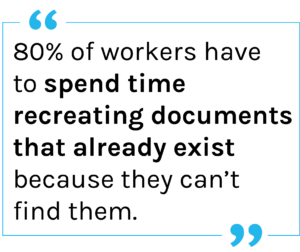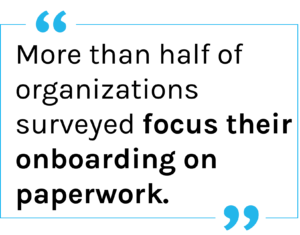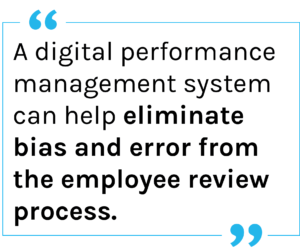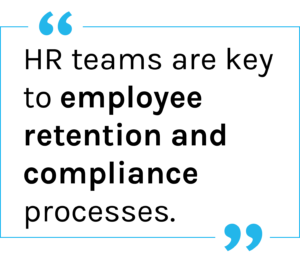How to digitize your paper processes to increase security, remove human error, and streamline workflows.
 Human resources offices are the hubs of talent at your institution. They find the best candidates in the hiring pool, bring them into the right roles, and work to retain and develop that talent. Doing all of this requires a great deal of information—often sensitive data, like social security numbers, salary data, performance review scores, and more. Dealing with this much information through manual processes like spreadsheets can be time-consuming and also risky—both from an accuracy and a security standpoint. Read on to see the most important digitization steps you can take in 2022.
Human resources offices are the hubs of talent at your institution. They find the best candidates in the hiring pool, bring them into the right roles, and work to retain and develop that talent. Doing all of this requires a great deal of information—often sensitive data, like social security numbers, salary data, performance review scores, and more. Dealing with this much information through manual processes like spreadsheets can be time-consuming and also risky—both from an accuracy and a security standpoint. Read on to see the most important digitization steps you can take in 2022.
1. Eliminate Paper Record Keeping
Paper, spreadsheet, and email-based record-keeping are outdated, inefficient, and potentially risky ways to organize your HR processes. Paper records are vulnerable to loss, theft, or damage, thanks to papers left on desks, unlocked filing cabinets, accidental email CC’s, or basement floods. In fact, the average large organization misplaces a file every 12 seconds and 80% of workers have to spend time recreating documents that already exist because they can’t find them. Not only does this missing information lead to security concerns, but it makes compliance and reporting more difficult. Recreating lost documents or spreadsheets also opens up more room for human error and mistakes that your office can’t afford.
Don’t forget that looking forward, working in the office may not be the rule for your team. According to Slack’s Future Forum, 83% of workers surveyed don’t want to work in an office full time—and colleges and universities aren’t going to be an exception to this hybrid future. If employees are working from home at times, manual record-keeping is even more of a barrier. Physical documents can’t be shared between employees working in different locations, and document sharing over email isn’t always secure.
workers surveyed don’t want to work in an office full time—and colleges and universities aren’t going to be an exception to this hybrid future. If employees are working from home at times, manual record-keeping is even more of a barrier. Physical documents can’t be shared between employees working in different locations, and document sharing over email isn’t always secure.
The secure, error-reducing, hybrid-office friendly solution is a centralized employee records management system that safely stores the sensitive information your team needs and makes it accessible to those who need access, whenever and wherever they need it.
2. Make Onboarding Digital
 Onboarding processes involve dozens of forms for HR to create, new hires to fill out, and HR to process, scan, and enter elsewhere. Traditional onboarding processes are full of opportunities for error, due to missed or lost documents or emails, and opens up employee’s sensitive data to the risks of manual record keeping. Onboarding is a new hire’s first impression of their chosen workplace, and a slow-moving, complicated process that gets tripped up by a missed email isn’t the best first impression for your institution. In fact, 64% of new hires would leave a new job within a year because of a bad onboarding experience. More than half of organizations surveyed by the Human Capital Institute focus their employee onboarding on paperwork—but is paperwork the only thing you want your new employees thinking about? When you have an automated digital onboarding system that ensures the right paperwork gets completed accurately and on time, there is more room for creativity in your onboarding process. Taking the manual paperwork and constant follow-ups out of the process leaves time to think about what other activities might help a new hire prepare for their role, like mentoring opportunities or community engagement activities.
Onboarding processes involve dozens of forms for HR to create, new hires to fill out, and HR to process, scan, and enter elsewhere. Traditional onboarding processes are full of opportunities for error, due to missed or lost documents or emails, and opens up employee’s sensitive data to the risks of manual record keeping. Onboarding is a new hire’s first impression of their chosen workplace, and a slow-moving, complicated process that gets tripped up by a missed email isn’t the best first impression for your institution. In fact, 64% of new hires would leave a new job within a year because of a bad onboarding experience. More than half of organizations surveyed by the Human Capital Institute focus their employee onboarding on paperwork—but is paperwork the only thing you want your new employees thinking about? When you have an automated digital onboarding system that ensures the right paperwork gets completed accurately and on time, there is more room for creativity in your onboarding process. Taking the manual paperwork and constant follow-ups out of the process leaves time to think about what other activities might help a new hire prepare for their role, like mentoring opportunities or community engagement activities.
3. Stop Manually Manipulating Your Sensitive Data (Automate Reporting)
Another data management area that is prone to mistakes for HigherEd HR offices is compliance reporting. Manual data manipulation via spreadsheets involves collecting data from varying sources and compiling it in a time-consuming manner—meaning that human error can impact a final report and, by the time a report is finished, the information is likely out of date. When dealing with compliance or auditing, your institution can’t afford to share old or mis-typed information. To get the most accurate and up-to-date information and analytics, your office needs real-time information pulled from every corner of your campus—and this can’t happen without a centralized, digital platform. The right talent management system—like PeopleAdmin’s—will offer analytics and reporting capabilities, as well as integrations with other software on your campus to pull all metrics together into a single source of intelligence.
4. Put Performance Management into the Cloud
Talent is the lifeblood of your institution and retaining current employees is a vital aspect of an HR team’s work. Employee turnover is costly, so why not update something as important as your performance management process? Keeping performance management and employee evaluation de-centralized and paper-based opens up a lot of room for error. Manual performance management processes can lead to missed reviews, incorporated bias, back-and-forth emails, and snapshot-in-time evaluations that don’t take enough information into account. If your institution is using an ad-hoc review process like this, there is likely no standardization and employees won’t know what to expect across campus. A digital performance management system can empower your managers, eliminate bias and error from the review process, and make sure that every faculty and staff member at your institution is getting the feedback they need to grow, improve, and further your institutional mission.
so why not update something as important as your performance management process? Keeping performance management and employee evaluation de-centralized and paper-based opens up a lot of room for error. Manual performance management processes can lead to missed reviews, incorporated bias, back-and-forth emails, and snapshot-in-time evaluations that don’t take enough information into account. If your institution is using an ad-hoc review process like this, there is likely no standardization and employees won’t know what to expect across campus. A digital performance management system can empower your managers, eliminate bias and error from the review process, and make sure that every faculty and staff member at your institution is getting the feedback they need to grow, improve, and further your institutional mission.
5. Integrate Your Systems
Did you know that the average employee spends 5.3 hours a week waiting for information from coworkers due to lack of centralized record keeping? If your team doesn’t have access to the data they need, when they need it, your office will be impacted by wasted time and by actions taken in error without the complete information. We know all of this data exists somewhere—the challenge is access. How can you make sure information exists in places your team needs it without adding the burden of manual re-entry into multiple systems? This is where an integrated system comes in. When considering digitization of your talent management processes and data storage, your institution should ensure that the systems talk to each other. For instance, PeopleAdmin’s talent management platform integrates with your existing HRIS, ERP, and other on-campus software, meaning that the information you already have will be pulled into a centralized, secure, accessible place—without any error-ridden manual re-entry.

Final Thoughts
When ushering your HigherEd institution through the digital transformation, don’t forget about your talent management processes. HR teams deal with sensitive data and are an important entry point to your institution for new hires. They are key to employee retention and compliance processes, and manual workflows just aren’t cutting it anymore. Upgrade your talent management team to a centralized, digital system and see what you can do next.